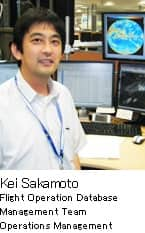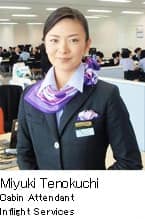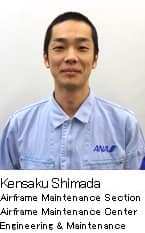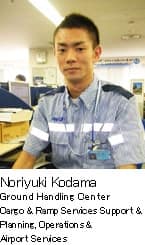
Under the ANA Group Safety Principle, “Safety is our promise to the public and is the foundation of our business,” we practice responsible conduct with integrity as we create peace of mind and confidence in the ANA Group.

I am a Boeing 787 co-pilot. As the launch customer for the model, the ANA Group worked with Boeing to resolve many issues to develop a state-of-the-art passenger aircraft. Even after introducing the aircraft, the ANA Group continues to make improvements for safer flight operation methods. Owing to various restrictions arising from its complex weather conditions and the restricted airspace, Japan is considered a difficult country for aviation. Pilots must have abilities at the world’s highest level in order to acquire national qualifications, and we maintain our qualifications and skills through ongoing examinations. In addition, as a company pilot, I am working to create new flight methods for an appropriate response in the event of a large-scale disaster. I will continue my studies to offer safer flight operations while embracing new technologies, based on the flight operation skills passed down over 50 years of ANA’s corporate culture and safety.


I am in charge of meteorology in Operations Management, where I collect the latest data from domestic and overseas weather forecasts to provide aircraft and related departments with timely information that affects flight operations. In particular, to minimize the impact from approaching blizzards, typhoons and developing low atmospheric pressure that can have a major impact on flights, I play a role in our response by conducting detailed analysis of original simulations based on data from the Japan Meteorological Agency, in addition to referencing past performance data. Moreover, in daily operations I select altitudes and routes based on analysis of airspace where turbulence is predicted, and also carefully judge aircraft storage and service advisability when faced with typhoon-strength winds. Meteorological information from external organizations is advancing every year, and we plan to make full use of such information through system improvements, as well as staff education and other activities, as we work to improve flight quality and safety.

I’m currently the Quality Supervisor for our Haneda Airport passenger services. As an airport staff member, during boarding procedures and other activities I carry out a cycle of searching for hidden dangers and deficiencies in our operations, proposing improvements for the problems I find, implementing the measures and verifying the results. Airport staff must be very sure to check every boarding pass at the gate, accurately determine the number of boarding passengers, notify staff about the latest information on dangerous items that cannot be carried on board, and thoroughly check these items on the spot. I work to collect and share information about procedures and behaviors that may lead to human error in order to help staff members identify problems quickly. By continuing to predict and prevent risks throughout our work, we aim to raise our safety quality to even higher levels.


As a Safety Leader, my role is to carry out safety awareness education and safety promotion activities for other crew members. The number of boarding passengers, weather, flight time, crew composition, aircraft model and other variables create a very different environment for every flight. For this reason, on every flight the crew shares measures against possible risks arising from weather and other variables, and conducts reviews and improvements after flights. We believe it is important to stay on top of the latest safety information and use it in risk management. To ensure safe, secure operations on daily flights, I confirm others’ understanding based on our manuals, give alerts in accordance with conditions, and proactively report near-miss incidents and my observations about safety. In addition, the organization as a whole implements various initiatives to improve safety and quality. As each person reliably executes his or her duties to improve our performance as a team, we aim to ensure the world’s highest level of safety.

I do heavy maintenance of aircraft at the Airframe Maintenance Center at Haneda Airport. The ANA Group grades all maintenance work according to difficulty and criticality, and work is performed only by state-certified maintenance staff with the aim of aircraft that are absolutely safe. In addition, based on the premise that mistakes can happen even when you pay attention, we have also introduced an inspector system for third parties to check the quality of maintenance work. Also, all maintenance staff share and practice key maintenance points based on the knowledge and experience built up within the Group over many years. As a maintenance staff worker, I remember to stop at key points throughout the work flow and conduct numerous checks until I am satisfied so that I can finish each job with confidence.

For safe and accurate ground handling work, we take precautions against accidents and problems, prevent their recurrence and carry out performance checks. Precautions include training to eliminate human error, thorough use of point-and-call checks in our work, and procedures for accurate work even under time restrictions.
When problems occur, we promptly confirm the situation and take steps to prevent a recurrence. After a month, we check whether countermeasures have been thoroughly implemented and are effective at the airport where the problem occurred, as well as at other airports. Handling changes in step with changes in the environment. I therefore aim to create a framework that displays our strong on-site capabilities, repeatedly revising the handling system at each airport from various angles to enable the most appropriate response to even minor changes.






























